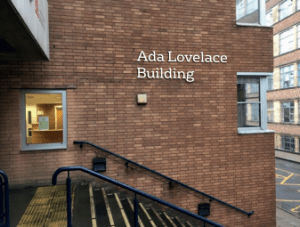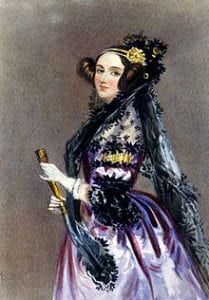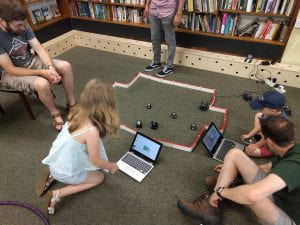The Ada Lovelace Building: A New Home for Engineering Mathematics at Bristol
Engineering Mathematics embedded in an Engineering Faculty is a unique proposition in the UK. The School of Engineering Mathematics and Technology combines world class teaching, multidisciplinary staff, strong industrial partnerships, and world leading research. Head of department Professor Anthony Mulholland explains what the new space means for staff and students and why we’ve named the building after Ada Lovelace.
A new space for collaboration
 Our degree courses have an emphasis on the mathematical modelling of industrial problems. This training requires significant input from our industry partners and bespoke workshop style facilities that enable group work and mathematical discussion. The department’s move to the Ada Lovelace Building provides a significant enhancement to our teaching facilities and creates a bespoke learning space for our students. The success of the department’s teaching programmes is due to the commitment and quality of our staff. Staff and students work closely together on industrially relevant problems that require mathematical models to be created, solved and the results communicated. We’re proud of our collegiate culture where all individuals and ideas are valued.
Our degree courses have an emphasis on the mathematical modelling of industrial problems. This training requires significant input from our industry partners and bespoke workshop style facilities that enable group work and mathematical discussion. The department’s move to the Ada Lovelace Building provides a significant enhancement to our teaching facilities and creates a bespoke learning space for our students. The success of the department’s teaching programmes is due to the commitment and quality of our staff. Staff and students work closely together on industrially relevant problems that require mathematical models to be created, solved and the results communicated. We’re proud of our collegiate culture where all individuals and ideas are valued.
Best in the UK
Engineering Mathematics has been named best in the UK for General Engineering in the Guardian University League Tables 2020 and in 2021.
Our excellence in teaching is also reflected in our NSS performance – 97% Overall Satisfaction in 2020.
More about The School of Engineering Mathematics and Technology
The breadth of the discipline backgrounds of the staff, and our unique position straddling mathematics and engineering, acts as a strong pull to world leading researchers. We attract people who are passionate about working across discipline boundaries and this produces a high degree of common goals, high staff morale, and a supportive and caring environment for everyone.
When we designed our new teaching and research facilities we wanted to ensure that our new building had a name that we could all feel proud of as a community. After extensive consultation with staff, students and our industrial advisory board we decided as a group that The Ada Lovelace Building was the perfect choice.
Why Ada Lovelace?
Ada Lovelace was born Augusta Ada King in 1815. She was the only legitimate child of the poet Lord Byron. Ada was raised by her mother, Lady Annabella Byron who had an interest in mathematics and insisted that Ada be tutored in mathematics and science.
Aged sixteen Ada met polymath Charles Babbage and corresponded with him at length about his Difference Engine and his next, more ambitious project The Analytical Engine. This device (which was never built) is now considered to be the first computer. Babbage’s work on the Analytical Engine was written up in French and due to her reputation as a scientist (and linguist!) Ada Lovelace was invited to translate the document to English.
 Ada took on the task with gusto. It took nine months and included an appendix of commentary which was three times as long as the translation itself. Signed only with the initials ‘A.A.L.’ (for ‘Augusta Ada Lovelace’), this commentary is the most definitive source on the envisaged Analytical Engine and its potential. Most contemporary scholars didn’t see the value of Babbage’s work, nor the additional insight that Ada brought with her translation. Modern scientists now recognise that Ada’s commentary contains the world’s first computer program (for calculating Bernoulli numbers).
Ada took on the task with gusto. It took nine months and included an appendix of commentary which was three times as long as the translation itself. Signed only with the initials ‘A.A.L.’ (for ‘Augusta Ada Lovelace’), this commentary is the most definitive source on the envisaged Analytical Engine and its potential. Most contemporary scholars didn’t see the value of Babbage’s work, nor the additional insight that Ada brought with her translation. Modern scientists now recognise that Ada’s commentary contains the world’s first computer program (for calculating Bernoulli numbers).
As with women and marginalised people throughout history Ada Lovelace’s innovation and significance to her field was largely forgotten. It wasn’t until Alan Turing started delving into her work in the 1950s that Ada Lovelace’s contribution to the fields of science, mathematics, computer science and engineering began to be recognised by the modern scientific community.
What is Engineering Mathematics?
Engineering mathematics is the art of applying maths to complex real-world problems; combining mathematical theory, practical engineering and scientific computing to address today’s technological challenges.
Ada Lovelace has become symbolic of marginalised voices whose contributions have been forgotten by history. Her potential was unlocked by the privilege of her birth. Her excellence and exceptional position reminds us to question how many people could have achieved similar feats had they enjoyed equality of education, opportunity and experience.
Naming our building Ada Lovelace signals our determination to ensure that education is available to everyone irrespective of their background. We will also redouble our efforts to ensure that there is a balanced gender representation of students in Engineering.
An ongoing commitment
The launch of International Ada Lovelace Day in 2009 has helped to raise Ada’s profile, and encouraged people around the world to talk about the women in STEM who inspire them. We can’t just put a name on a building and pat ourselves on the back. The annual reminder provided by Ada Lovelace Day represents our ongoing commitment to building diversity and inclusivity within Engineering Mathematics.

We’ve got big plans. Multidisciplinary working is in the DNA of the staff and students in Engineering Mathematics and the new space provides opportunities for hosting activities that will produce new, mutually beneficial research and teaching collaborations. The environment will enable new research collaborations with other disciplines and there’s room to welcome visiting academics on mini sabbaticals. The space will also be used for outreach, supporting our widening participation plans and helping to ensure that anyone with the talent can become the engineers and mathematicians of the future.


